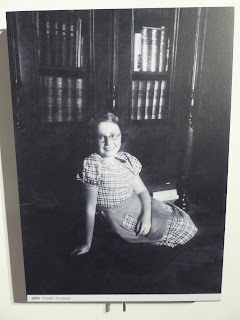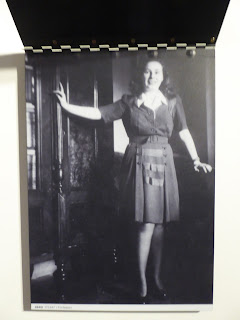Fortepan is a vast archive of photographs that started as a collection made by Miklos Tamasi and Akos Szepessy, two friends, who from the 1990s onwards bought discarded pictures in jumble sales and gathered them up from the street throw-outs that happen in each Budapest district twice a year. When they put what they had online in 2010, other people joined in, adding their own photographs. The archive is enormous and fascinating and you can find it here.
The exhibition from the archive is beautifully curated so, if you are in Budapest, I recommend going to see it - it is on until 25 August. Even though all the photographs on display can be found on-line, the way they are presented in the exhibition adds resonance and depth to the experience of looking at them. Having forked out an absurdly large sum of money recently to see the exhibition of Martin Parr's pictures at London's National Portrait Gallery, I was struck by how this haunting collection of amateur snaps manages to ask many of the questions he asks with his photography and to highlight many of his themes, but without what I felt was his slight arrogance and mild contempt for humanity. Because of the mixed fortunes of the Hungarian nation during the last century or so, the pictures also tell a very remarkable and poignant story, showing hardship and resilience and a lot of sadness.
There were two particularly striking sections of the exhibition that it would be especially hard to replicate by looking through the digital archive. I will therefore try to give an idea of them here.
The first was a set of displays called something like Twin Pictures (that wasn't exactly its name, but I can't recall the precise title). In this section, you saw a photograph that appeared to be hanging by itself on the wall, but you then realised there was a small handle in the middle of the bottom of the photograph's frame. When you lifted this, you discovered the photograph you'd been looking at was actually mounted on a hinged board. When you raised the board, another photograph of the same subject but taken at a different moment was revealed hanging underneath.
Some of the twinned pictures were dreadful, highlighting the effects of war and revolution:
This one, for instance, shows the Castle District seen from a balcony, probably on the lower slopes of the Gellert Hill, in 1943.
This one shows the same scene from the same vantage point in 1946. Incidentally, both are from the collection of Carl Lutz, who was Swiss vice consul to Hungary during the Second World War and saved tens of thousands of people's lives, an extraordinary and very courageous man, who thought nothing of plunging into the icy Danube to rescue someone the Arrow Cross were trying to murder and then - still drenched, in freezing weather and soaked clothes - taking on the German authorities who were allowing the attempted murder to take place. You don't meet many like him on the ordinary diplomatic circuit
This picture shows Kossuth Lajos street in 1954, during a May Day parade:
This shows the same scene during the 1956 uprising. Both can be found in much more vivid detail at the Fortepan site. Search for the first by entering the number 129449; for the second, enter 129465.
More cheerful was this pair, in the background of which you can see the building where the Fortepan exhibition is being held:
In this sequence, I though there was something very touching about the character of the person in both photographs: in the second we see she has grown up but has not lost a certain innocent openness in the process:
The other section that I thought had been brilliantly conceived by the curators was one in which they chose to display the letters they had received from members of the public who had come upon a picture they recognised in the archive. The letters are very touching; their writers are so thrilled to have a little glimpse back into their past and to see people they were fond of who are no longer around.
In response to this next picture, someone wrote to the archive: "Fortepan is a wonderful thing. I suddenly came across the old family shop with our old family home. It was my great-grandmother Mrs Izso Gotzler (Debora Neumann) who founded the corsetry shop in Ujpest. After the war her daughter took over the business, because Debora never returned from Auschwitz. By the time I was born, the shop had closed and Manyoka (Margit) had gone into retirement: there were few memories of the house. Then I happened to open the Fortepan site and there was the shop wth Manyoka on the signboard."
Imagine having to write about a relative, "Debora never returned from Auschwitz".
In response to this picture, another person wrote: "The smiling face of our father, who died 25 years ago, can be seen in some of the pictures. He is one of the goalkeepers and can be seen squatting in the middle of this shot. The picture must have been taken in the late 1960s or early 1970s at the playing field belonging to the Motorcycle and Machine Factory on Fehervari Street. I was born in 1970 and I have a clear but fleeting memory of my father waving at me from behind the fence."
(I should explain that the title of this post refers to my mind's insistence on thinking of Fortepan as Panforte, which is, of course, a Sienese cake)












No comments:
Post a Comment